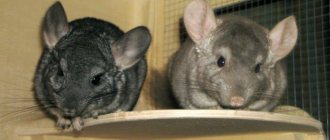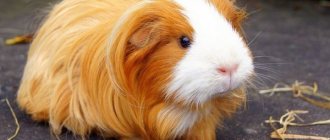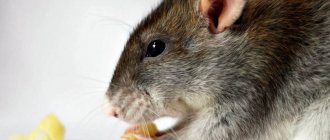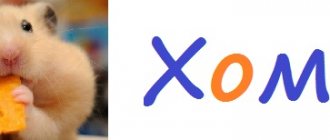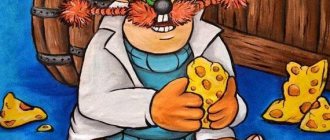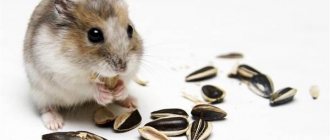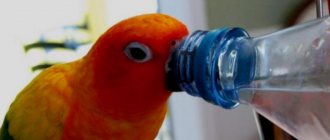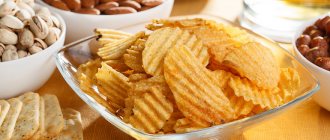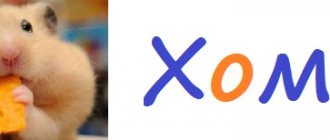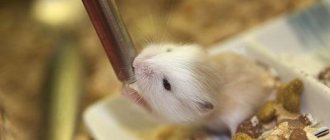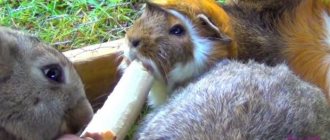Why do you need greens in your diet?
A hamster's diet should be varied. In addition to vegetables, fruits and berries, they love to feast on grass, especially lettuce. It is worth considering that plant food is not the main source of nutrition, it is only part of the animal’s daily diet.
Benefits of grass in a rodent's diet:
- rich in vitamins (ascorbic acid, carotenoids);
- valuable source of fiber and minerals;
- the use of certain types of herbs contributes to the rapid recovery of the animal;
- shelter material. Hamsters use leaves to build homes for their babies.
Grain mixtures
Ready-made mixtures in the form of granules or grains purchased at a pet store are suitable for feeding rodents. It’s not difficult to prepare food for your hamster at home by mixing oats, wheat, millet, corn, pumpkin and watermelon seeds. To protect the animal from vitamin deficiency, sprouted grains are added to the diet.
Hamsters eat sunflower seeds with great pleasure, but you should not overuse this delicacy, otherwise your pet will refuse any other grains in the bowl. To diversify the diet and enrich the diet with proteins and beneficial microelements, dry peas, chopped nuts, and rapeseed are added to homemade food.
During pregnancy and feeding their offspring with milk, females need an increased amount of protein, which can be provided by adding legumes to the diet. However, these should not be young or freshly harvested peas. Such a component will inevitably cause the development of obesity in the animal.
What kind of grass and greens can be given?
Greens suitable for a hamster can be divided into several groups:
- feed: clover, wheat, alfalfa, oats;
- tree leaves - apple, cherry, apricot, willow, birch;
- weeds (meadows) - nettle, wheatgrass, dandelion, plantain, burdock, clover;
- medicinal herbs: knotweed, traveler, whelk;
- greens from the garden - dill, lettuce, parsley, spinach, celery, carrot and beet tops.
All of the above plants have different tastes and composition. Therefore, it is recommended to combine them and change them daily in the diet so that the rodent receives more healthy vitamins and minerals.
Garden greens
Plant food from the garden is considered the healthiest and safest for a hamster. Each culture is useful in its own way.
- Parsley – rich in B vitamins, folic acid, phosphorus, potassium, sodium. These elements maintain the water-salt balance in the animal’s body and alleviate the symptoms of intoxication. Parsley has a positive effect on the rodent's digestive system.
- Dill – helps strengthen the immune system, improves the functioning of the gastrointestinal tract. The hamster needs to be fed in reasonable quantities - once every 2-3 days.
- Lettuce leaves - contain potassium, calcium, phosphorus, iron, magnesium. Can be included in your diet daily.
- Spinach – among garden plants, is considered the leader in the content of nutrients. It has a beneficial effect on the digestive system and helps cope with constipation.
- Carrot tops contain calcium, which ensures strong bones, and vitamin C. These components help prevent the development of diseases of the cardiovascular system and act as a means of preventing diseases of the endocrine system.
- Celery – contains a large amount of phosphorus, vitamins B1, B2, B6, B12, magnesium. Give once a week in small quantities.
Adding healthy herbs to your hamster's diet will saturate his body with vitamins and improve his health.
Weeds
These plants serve as the main food in their natural habitat. Meadow grasses can also be offered to domestic hamsters: they contain no less useful substances than garden greens.
- Dandelion - only leaves are given to rodents. The plant is rich in vitamin E, which has a beneficial effect on the animal's coat. When used on a regular basis, the hairs become soft and shiny.
- Nettle is useful due to its iodine content. It is better to offer hamsters young shoots.
- Wormwood – has a diuretic and anti-inflammatory effect.
- Wheatgrass - usually placed in a pet's cage when it gets a cold. The plant has an immunomodulating and antitumor effect.
Medicinal herbs
Medicinal herbs should be an addition to the main diet. The animal needs them as a prophylactic against various diseases, and also contributes to a speedy recovery.
- Plantain – has an antimicrobial effect.
- Tomato is considered a natural antibiotic and strengthens joints.
- Burdock – strengthens the hamster’s immunity. Helps cope with skin diseases and gets rid of parasites.
- Rosehip – has a wound-healing effect.
- Knotweed – has diuretic and anti-inflammatory properties.
If any disease appears, more of certain medicinal herbs should be given until the rodent is completely recovered.
Dried herb
To add greens to your hamster’s diet in winter, you can collect them and dry them in summer. Collect dandelion, nettle, burdock, plantain in an environmentally friendly place, rinse and lay out in a thin layer on paper. Dry for 5-7 days in a dry and dark place.
Dried plants retain all their beneficial properties and become an excellent treat for a hamster during the cold season.
Composition of parsley
Parsley is a very unpretentious plant, so it can grow in almost any soil. In most countries it is a popular addition to the main dish.
Contains many useful elements:
- B vitamins;
- ascorbic acid;
- folic acid;
- niacin;
- phosphorus;
- sodium;
- calcium and many others.
All these positive qualities have a positive effect on the connective tissues of the body, relieving symptoms of intoxication, and maintaining water-salt balance in the body.
There are two types of parsley: curly and ordinary, but both are equally useful.
How and how much to give
Food for a small rodent is selected taking into account its breed, age and health status. For full development and good health, a hamster requires a balanced diet. His diet should consist of:
- grain mixture;
- greenery;
- products of animal origin;
- vegetables and fruits.
Plant foods are a source of additional vitamins. This includes both grass and tree branches. The latter are necessary for a pet to grind down its incisors.
Plants in the diet of rodents should be combined with grain mixtures and animal products. It is important to understand that greens are not the main food, but an addition to the diet.
There are a few things you need to know before offering food to your hamster.
- A lot of bacteria and dust accumulate on the leaves of fresh greens. Therefore, the grass must be thoroughly washed under running water.
- It is better to choose young grass. The old one will be tough, which will cause damage to the rodent's cheek pouches.
- If the plant is lethargic, it should not be offered to the animal. Such greens will be less tasty and juicy. And if she lies in a cage for some time, she will begin to rot.
- Rodents should be offered several types of plants at once so that they receive the maximum amount of vitamins.
Greens can be given when the rodent is 1 month old. By this time, the animal is able to chew vegetables, fruits, and dry food on its own. The stomach of a month-old pet is already stronger.
Rules for feeding dzhungariks
Owners of these funny hairy rodents need to remember that the animals' diet must be balanced, varied and consist of fresh, chemically safe foods.
The hamster has a fast metabolism, and during the day the hamster eats a volume of food equal to 70% of its body weight. In addition, this type of rodent is predisposed to diabetes and obesity.
These factors must be taken into account when feeding the animal.
Diet
There is no consensus on the diet of the dwarf dog among experienced breeders and veterinarians. Some recommend feeding the animal once a day, in the evening, since the hamster is nocturnal and is most active in the twilight hours. Others insist on giving food twice: after the pet wakes up in the morning and in the evening. Observe your hamster to determine the best feeding schedule for him.
For a long time it was believed that the hamster does not need water, since he is a resident of semi-desert areas and he gets enough moisture from juicy vegetables and fruits.
In fact, in nature, dungarians drink dew from the grass, albeit in small quantities. Therefore, it is necessary to give water to your hamster. Fresh filtered or bottled still water is suitable for this. Raw tap water is not suitable, because... contains many impurities, hardness salts and chlorine. Even boiling does not remove these substances.
The water in the drinking bowl is changed every day, and once a week the drinking bowl is thoroughly washed and disinfected.
Vitamins for dzungarians
Pet stores sell special vitamin preparations for hamsters. They are produced in the form of liquid concentrates and tablets. Please consult your veterinarian before purchasing these products. Manufacturers have already included vitamin supplements in many grain mixtures for hamsters.
Basic mistakes and how to avoid digestive problems
Errors in compiling a diet for dzhungarika arise due to insufficient knowledge of its species characteristics and the influence of various products on the animal’s body. And the desire to feed your pet food from the table leads to serious digestive problems in the rodent.
What herbs should not be given to a hamster?
Among plant foods there are herbs that should not be given to rodents. They pose a danger to the animal and can cause harm to health.
- Sorrel is a plant that is too acidic. Irritates the gastric mucosa.
- Mint, lemon balm - aromatic herbs act as an allergen.
- Garlic and onions (feathers) - will not be liked due to their specific aroma and taste.
- The tops of tomatoes, potatoes, peppers and eggplants contain a toxic substance - solanine.
- Coniferous trees contain resin, which negatively affects internal organs. Causes a severe allergic reaction.
- Beet tops can be given to your hamster in limited quantities. Abuse of the product causes diarrhea.
- St. John's wort. While this is a medicinal plant for humans, it is dangerous for hamsters.
- Tarragon is given with caution. The herb is too aromatic and may cause an allergic reaction.
Animals look at indoor plants with curiosity. The leaves of your favorite flowerpot often end up in the hamster's teeth. If a houseplant is poisonous, it may harm the animal. Therefore, owners should keep flowers away from their pets.
Houseplants that pose a danger to your hamster:
- aloe;
- begonia;
- Kalanchoe;
- oleander;
- ivy;
- azalea;
- alpine violet;
- gloriosis;
- cycad;
- succulents.
Plants must be present in the rodent's diet. Every owner should know what plants can be given to a hamster so as not to harm him. The lifespan of rodents depends on their diet. Animals that eat greens on a regular basis are more active and less likely to get sick.
What kind of grass can you give to your pet?
For consumption, the animal can be given any herb that is suitable for humans in its raw form. But it is worth remembering that the animal is unlikely to like onions, but the hamster will not refuse salad. Greens from the street can only be given if they are collected away from highways and busy traffic.
Clover, burdock (young shoots), and wormwood grass in moderate doses are suitable for rodent food. It is also worth remembering a number of the following points:
- Wheatgrass is considered a common plant. It can also be seen in hay intended for rodents. A moderate amount of wheatgrass will benefit the rodent.
- Knotweed is often used in folk medicine. This medicinal herb is also safe for rodents.
- As for dandelion, your hamster can only eat the leafy part of the plant. But you need to feed it to the animal carefully. If there is too much dandelion, it can harm the rodent's gastrointestinal tract. It is necessary to introduce dandelion into your hamster's diet only after consulting a veterinarian.
- Plantain, in addition to knotweed, is also recommended for hamsters in unlimited quantities.
- Another herb that has high nutritional value is nettle. This plant is useful for rodents as a means of preventing vitamin deficiency. In early spring, the animal is allowed to give nettle leaves. But before that, they should be boiled to remove the acid. Then squeeze, cut and give to your pet.
can you give hamsters salad? They bought me a hamster, but I don’t know what to feed it.
1. Dry ready-made food for hamsters 2. Nuts (almonds): walnuts, cashews, hazelnuts, sesame seeds, peanuts, chickpeas, carob 3. Wheat sprouts, oats, alfalfa, bamboo 4. Seeds: sunflower, pumpkin , melon 5. Cereals: barley, wheat, oats, buckwheat, rolled oats, lentils, peas, beans, beans 6. Berries: strawberries, currants, gooseberries, blueberries, cherries (pitted!) 7. Vegetables and fruits: pumpkin (raw ), apples, carrots, bell pepper, cucumber, tomato (not winter), radish, radish, zucchini, zucchini, beets, pear, apricot, peach, melon, squash, turnip, eggplant (except overripe ones!), grapes and raisins, banana and banana chips, cauliflower (raw and cooked, but rarely), fresh and dried corn, green beans (can be defrosted frozen), Chinese salad (aka Chinese cabbage), broccoli, frozen mixed vegetables, plums (a little), fresh peas, chickpeas (lamb peas, soak overnight), young peas in shells, rose hips (peeled and in small quantities), celery (a little, rarely) 8. Boiled vegetables: carrots, beets, pumpkin, peas (without salt and cook briefly ) 9. Greens: parsley, dill, lettuce / and iceberg lettuce /, dandelion and plantain leaves, clover, nettle 10. Dried fruits: raisins, dried apricots, dried apples and pears, banana chips 11. All deciduous tree varieties: beech, ash, willow, maple, oak, poplar, walnut, birch, fruit trees such as cherry, pear, apple.
12. Rose petals 13. Popcorn without salt, sugar and fat (prepared at home) - as a delicacy 14. Dryers of the “Simple Drying” type without sugar and additives - as a delicacy 15. Carob fruits As a protein component of the diet (2-3 times one thing per week):
14. Boiled chicken without salt and seasonings 16. Yogurt without sugar and additives no more than 1% fat, bifilin 17. Cottage cheese 0-1% fat 18. Kefir 0-1% fat 19. Boiled chicken egg, boiled quail egg 20. Butterflies , mealworms, grasshoppers, earthworms (only purchased in pet stores!) 21. Low-fat boiled fish 22. Peeled shrimp (rarely) 23. Dried gammarus (only purchased in pet stores!)
For feeding young animals and sick animals:
24. Vegetable and meat baby food (without salt, sugar, soy) 25. Porridge with water, baby milk-free porridge without salt, soy and gluten, or just cereal soaked in water 26. Rice boiled until sticky (for diarrhea) 27. Vegetable oil (a little for constipation)
NOT RECOMMENDED, since products from this list can cause irreparable damage to the health of the animal:
1. Cheese 2. Ready-made food for budgies, birdseed, food for other rodents 3. Potatoes 4. Persimmons (only very sweet and absolutely non-astringent are allowed, rarely) 5. Acorns 6. Drops for rodents 7. White bread 8. Crispbreads (only mild ones can be given, which do not contain salt, sugar or seasonings) 9. Brazil nuts
1. SALT, SUGAR, SPICES 2. Butter 3. Citrus fruits 4. Breakfast cereals, muesli 5. Almonds 6. Garlic 7. Onions, leeks 8. Cherry, apricot pits 9. Raw potato eyes, potato skins 10. Sausage , sausages 11. Cow's, goat's milk in its pure form, as well as as a base for cereals 12. Sour cream, cream 13. Exotic fruits (and kiwi, pomegranate, avocado, pineapples too) 14. Everything fried and fatty 15. Dry pasta 16. Watermelon 17. Sorrel 18. Tulip 19. Kozinaki 20. Mushrooms 21. Honey (pure) 22. Branches of coniferous trees (pine, larch, spruce, false sugi), as they secrete resin harmful to hamsters. 23. Any herbs and plants grown in the city 24. Fruit juices 25. Black bread 26. Mint 27. Bloodworms, insects caught in nature 28. White cabbage, red cabbage, Brussels sprouts 29. Cookies, chocolate, ice cream 30. Figs
Can hamsters have parsley and dill?
With the arrival of summer, more seasonal products appear on our table: different varieties of berries, fresh home-grown vegetables, juicy greens straight from the garden. All of them contain a huge amount of useful substances and microelements. When we consume summer gifts for food, we often think about treating our pets to them. Hamsters, like other rodents, benefit from greens. Therefore, let’s consider whether hamsters can have parsley and dill, and how to serve them correctly.
Beans
Legumes are often a staple in a hamster's diet, including beans. It can be given in any form, including dry, fresh and thawed. However, it has the best effect on your pet’s health when consumed fresh, as it contains more nutrients.
IMPORTANT! Not all beans are good for your hamster. Red beans (kidni) can only harm him, since their toxicity will lead to deterioration of the animal’s digestion, which is why it should not be consumed.
Green beans are also suitable for consumption. It is most often found frozen, but pets prefer it fresh because of the juice it contains. Before serving defrosted green beans, check its composition; it should not contain any preservatives, which are often added to improve the taste of the product, and additives are dangerous for rodents.
Before giving it to the hamster, it is better to soak the beans, because this way they are better absorbed, giving useful microelements to the rodent’s body. For soaking, one night and water at room temperature is enough.
Peas
This product can and is even recommended for consumption fresh or soaked; consumption of whole pods is acceptable. The Djungarian hamster prefers raw chickpeas. It is acceptable to eat boiled peas; 10 minutes are enough for them to be ready, but adding any spices is unacceptable; the hamster’s digestive system simply cannot cope with spicy or fatty foods.
Rodent food from well-known manufacturers that have established themselves as quality products contains different types of peas, which indicates its undoubted benefits.
What kind of peas can you feed:
- If the animal refuses raw peas, try soaking or boiling them;
- You can give the plant with the cob;
- Split peas, which can be purchased at pet stores, are the best option.
Why shouldn't hamsters be given popcorn?
When manufactured in production, fats, sugars, and salt are added to the corn-based product to make the airy delicacy more attractive to the buyer. This is also what makes popcorn harmful to your pet. Djungarian hamsters can develop diabetes from such “goodies.”
If you want, you can pamper the animal with homemade puffed corn without additives. Sometimes it is present in this form in prepared animal feeds. This is convenient because... The contents of the pack are already ready to eat.
Rest assured, the manufacturer has thought through the quantity, nutritional value and safety for you. You just need to look at the daily value on the packaging and feel free to offer the treat to the animal.
Homemade treats
A number of caring owners, wanting to include the best in their rodent treats, prepare sweets themselves. This is not difficult if you know and combine the foods hamsters love:
- Hamsters love muesli perhaps most of all. You can mix cereal flakes with a banana, carrot or apple. There are two serving options: small balls or bars - at the discretion of the owner.
- Cookies are easy to make. It is enough to mix the protein with any animal’s favorite cereal and bake it like regular cookies.
- Hamster salad includes pine nuts mixed with any healthy lettuce leaf.
- Mix banana and cereal, roll into balls. You are allowed to add a few raisins.
- Wash the lettuce and clover leaves well, dry and chop. Mix and add walnuts.
- Add pre-beaten egg whites to your hamster's regular diet. Bake small flatbread cookies from the resulting dough.
